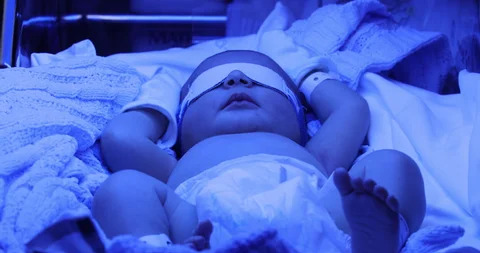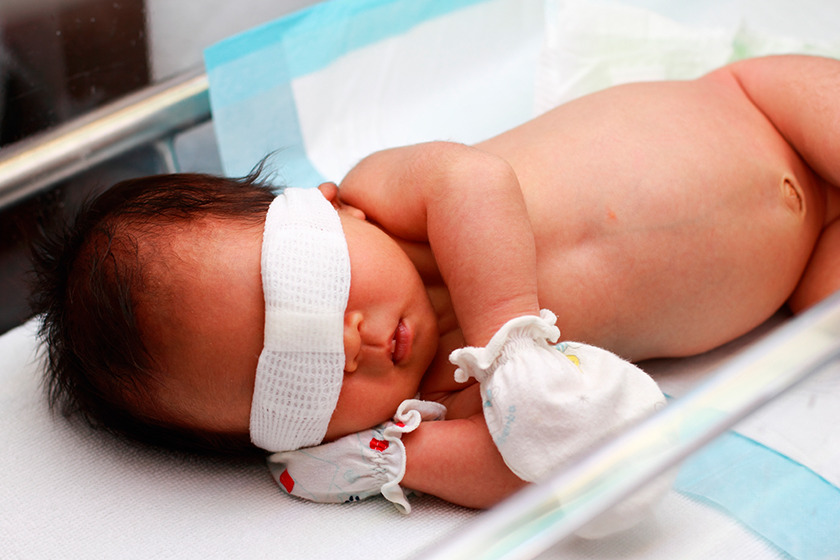Understanding When to Admit for Neonatal Jaundice Treatment: Phototherapy and Exchange Transfusion
Neonatal jaundice occurs in a significant number of newborns. While mild cases often resolve without intervention, certain bilirubin levels and risk factors signal the need for medical intervention such as phototherapy or, in severe cases, exchange transfusion.


What is Phototherapy?
It is the primary treatment for hyperbilirubinemia in neonates. It is a safe and effective treatment that uses blue-green light (460-490 nm) to convert bilirubin into soluble isomers, which are easier for the baby’s body to eliminate.
Types of Phototherapy Lights
The setup includes several light sources:
– Blue LED lights – known for high effectiveness.
– Compact fluorescent lamps (CFL) – available in cool white, blue, or green.
– Halogen bulbs and fiber-optic lights.
Administering Phototherapy
1. Room Temperature: Keep ambient temperature between 25° to 28°C to avoid hypothermia or hyperthermia.
2. Positioning: Remove the baby’s clothing (except for a diaper) and cover the baby’s eyes with an eye patch that does not block the nostrils.
3. Placement: Position the baby 30-45 cm below the phototherapy light, or as per the device’s recommendation.
4. Feeding: Breastfeed frequently, but minimize interruptions to phototherapy for maximum efficacy.


When is Exchange Transfusion Needed?
In cases of severe hyperbilirubinemia or high-risk scenarios, exchange transfusion (ET) may be necessary to prevent complications like kernicterus. ET is considered if bilirubin levels remain high despite PT or in the presence of specific risk factors.
Bilirubin Levels Guiding Phototherapy (PT) and Exchange Transfusion (ET) in Healthy, Term Infants
For term infants over 35 weeks without additional risk factors, the bilirubin thresholds for initiating phototherapy or exchange transfusion are as follows:
| Age (hours) | Bilirubin Level for PT (mg/dL) | Bilirubin Level for ET (mg/dL) |
|---|---|---|
| <24 hours | Pathological Jaundice | Medical evaluation necessary |
| 25-48 hours | 12 (consider PT), 15 (PT) | 20 (ET) |
| 49-72 hours | 15 (PT) | 25 (ET) |
| >72 hours | 15 (PT) | 25 (ET) |
Note: Bilirubin levels and clinical judgment guide treatment; risk factors such as isoimmune hemolytic disease, G6PD deficiency, asphyxia, sepsis, or acidosis may lower PT and ET thresholds.
Important Red Flags for Admission
– Jaundice in the first 24 hours of life (pathological).
– Rapid progression or appearance on the palms and soles.
– Signs of lethargy, poor feeding, temperature instability, or dark urine/pale stool.
Prompt medical consultation is essential if these red flags are present to determine if PT or ET is necessary.
FAQs
Q: What is phototherapy and how does it work for jaundice?
A: Phototherapy uses blue-green light to convert bilirubin into a form that can be excreted by the newborn’s body, effectively reducing bilirubin levels.
Q: What are the signs that my newborn needs phototherapy?
A: If jaundice appears within the first 24 hours, or if bilirubin levels exceed age-specific thresholds, phototherapy may be required. Consult a pediatrician for precise bilirubin testing.
Q: When is exchange transfusion considered for neonatal jaundice?
A: Exchange transfusion is considered if bilirubin levels remain high despite phototherapy, particularly in cases of rapid increase or the presence of risk factors like hemolytic disease.
Q: Can breastfeeding continue during phototherapy?
A: Yes, breastfeeding is encouraged, though sessions should be brief to maximize the time under phototherapy lights.
Contact Us
For more information or concerns about your newborn’s jaundice, please call us at [+918347990180] Check out all the services provided at Aashrey Child Clinic for your newborn [Click here].
External Resources
– [American Academy of Pediatrics – Neonatal Hyperbilirubinemia] – [World Health Organization – Jaundice in Newborns]
